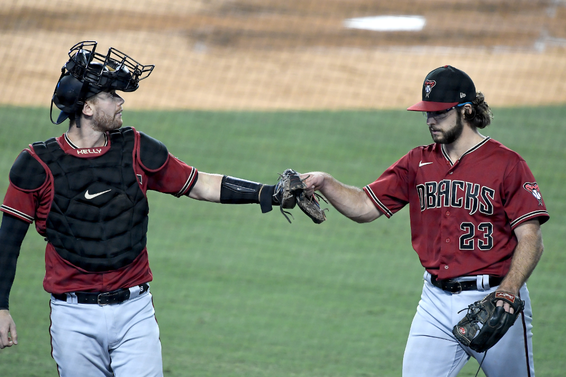
Here are some things that the average fan might know about Zac Gallen. He's a right-handed starter for the Arizona Diamondbacks. He was acquired in July 2019 in a trade with the Miami Marlins. He was a legitimate contender to win this year's Cy Young Award before his ERA ballooned from 1.80 to 3.15 over his two most recent starts. He wears rec specs.
Here are some things that the average fan probably doesn't know about Gallen. His legal name is Zachary Peter Gallen. His Players' Weekend nickname is "Milkman." (Get it? Gallen, gallon.) He was born in Somerdale, New Jersey and attended the University of North Carolina. His breakout is attributed by those in the know to improved spin efficiency. He was originally a member of the St. Louis Cardinals organization. He's baseball's Sisyphus, at least in a sense.
Gallen entered Tuesday with an insurmountable lead in attempted pickoffs. Combine the second-, third-, and fourth-ranked pitchers and that total equals his amount: 126. Here's the current pickoff attempt leaderboard:
1. Zac Gallen (ARI): 126 pickoff attempts, 0 pickoffs
2. Griffin Canning (LAA): 45 attempts, 2 pickoffs
3. Robbie Ray (TOR): 41 attempts, 0 pickoffs
T4. Corbin Burnes (MIL): 40 attempts, 0 pickoffs
T4. Anibal Sanchez (WAS): 40 attempts, 0 pickoffs
There are two remarkable aspects to that figure: 1) he's accumulated so many attempts when he's faced only 70 stolen-base opportunities (runner on first or second with the next base empty); and 2) he hasn't recorded a single pickoff. Not a one. Not even because the runner slipped getting back.
A stretch of futility like that in nearly any other capacity in baseball would likely result in a conversation, or a job change. Gallen, though, just keeps throwing over to first base. Why? In an effort to answer that question, we watched every single one of his 126 attempts this season.
Here's what we learned.

1. He's monomaniacal
This is not a revelation. Gallen has averaged nearly two throws over for every stolen-base opportunity, obviously he's stubborn bordering on obsessive. What's striking, though, is how frequently he compiles attempts during the course of single sequences.
There were 43 plate appearances in which he threw over at least once. Of those 43:
- He threw over at least two times on 33 occasions (77 percent)
- He threw over at least three times on 23 occasions (53 percent)
- He threw over at least four times on 10 occasions (23 percent)
- He threw over at least five times on five occasions (12 percent)
If you're a baserunner and Gallen throws over once, you should prepare for him to do it again -- and then you should then flip a coin as to whether or not he's going to throw over a third time.
Gallen doesn't seem to have shame in his game, either. He had one sequence where he threw over six times, another where he threw over eight, and then a scene where he tried to catch Jose Altuve napping on 11 occasions during one of Alex Bregman's plate appearances:
It would be fair to suspect that other players get tired of Gallen's shtick. For the most part, they concealed their annoyance. One notable exception to that trend was Austin Hedges, who seemed aghast after Gallen threw over a combined eight times in two plate appearances:
Christian Walker, Arizona's regular first baseman, never has to want for a game of catch.
2. His attempts are seldom close
With that kind of volume, you would think that Gallen would come close to picking off someone, if only by happenstance. He doesn't, not often.
The closest Gallen came was during a sequence with Colorado Rockies outfielder Ramiel Tapia:
On another occasion, Gallen forced Mookie Betts to do his best Superman impression:
Otherwise? You'd be better suited judging Gallen with a different measure. Such as, say, how frequently the runner had to dive to get back in. The catch is that a diving return can mean that a move is well-disguised, or it can mean that the runner felt comfortable taking a bigger lead.
With Gallen, you can take your pick of which explanation is more precise. We did the heavy lifting by counting how often the runner in question had to dive back in -- when we could, anyway: there were five occasions where the broadcast never showed the baserunner, including a few where the focus remained on the batter, or, in this case, on pitching coach Matt Herges:
In the 121 instances where the runner was visible, dives were deemed necessary on 49 occasions, or about 40 percent of the time. We should note that "dive" is a relative term:
Gallen's throw-overs don't have many discernible patterns to them, as it relates to the runner's behavior. Sixteen of the 43 sequences concluded with the runner diving back in, meaning he doesn't always throw over until the runner is taking smaller, less aggressive leads. Interestingly, only eight of the 43 started with the runner diving back in. To step back when Gallen is trying to pick you off is to laugh at a toddler's joke: you're encouraging them to repeat it ad nauseum.
To be fair, there is a craft to picking off runners that is similar to pitching itself. A lot of the best pickoff artists, especially right-handers, will set-up a runner by holding their best move. They'll lob the ball over to first, or show a watered-down version of their best move first. Predictably, a lot of Gallen's throws are low-probability lazy arcs that have no chance at recording an out:
A few even border on petty antics:
Gallen does break out his best move on occasion, especially during prolonged sequences, but it's only been good enough to nab one baserunner for his career. Here's that play:
That's from a game last August against the Rockies. The runner was Ryan McMahon. Gallen only had to throw over once.
3. He doesn't discriminate
Everything looks like a nail to a hammer, and every baserunner looks like Rickey Henderson to Gallen. Throwing over a lot when proven thieves, like Altuve and Betts, are on first base is sensible; throwing over when Pablo Sandoval on first is taking game theory too seriously:
Gallen is not displaying much confidence in the arms of his catchers when he takes it upon himself to tether a non-threat to first base. Sandoval, after all, has stolen one base since 2013. The catchers don't seem to take it personally, however, and sometimes they even partake. Here's Carson Kelly calling for Gallen to throw over by giving him the fist:
The teamwork makes the dreamwork.
4. His strategy may not be effective
Let's get to answering the question: why does Gallen throw over so often? We'll even throw in a bonus question to the obvious follow-up: does it work?
Ballplayers have a tendency to tell on themselves. A third baseman who takes a step or two toward the line could inadvertently alert a right-handed hitter that a changeup is coming and that they expect the batter to pull it. Likewise, a pitcher who throws over to this degree has to be overcompensating for something, and that something tends to be a slow delivery.
Contrary to popular belief, most stolen bases are because of the pitcher, not the catcher. It's the pitcher who dictates the runner's lead, and it's the pitcher who can take longer to get the ball to the plate than the catcher takes to fire it to second base. According to Baseball Info Solutions, Gallen is indeed slower than the norm … just not not by much. He takes about 1.63 seconds to complete the transaction, whereas the standard right-handed pitcher takes about 1.61 seconds.
It stands to reason that Gallen's constant pickoff attempts are his way of atoning for his slowish delivery. Unfortunately, for him and the Diamondbacks, it doesn't seem to accomplish the goal. Baserunners have attempted to steal against Gallen in nearly 10 percent of their opportunities, and they have succeeded once for every 15 or so opportunities; the league-average pitcher's figures in those same metrics this season are five percent and once every 26 opportunities.
There is a chicken-or-egg element at play here. Is Gallen's attentiveness dissuading more stolen-base attempts, or is he overplaying his hand? Would runners really attempt to steal more frequently if he threw over less often, or would he be better positioned to pick off runners if he was more selective about when he tried his luck? There's no way of answering those questions.
It does seem telling, however, that the sequence wherein Gallen threw over 11 times to keep Altuve from stealing ended with a stolen base.


















